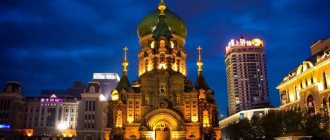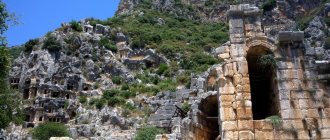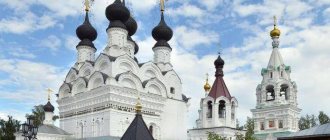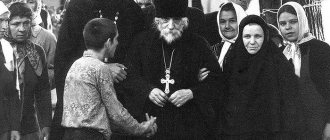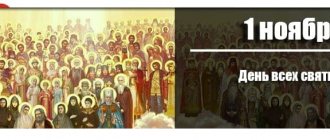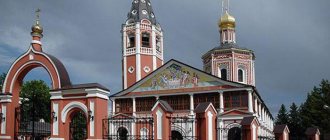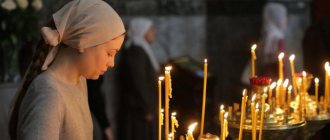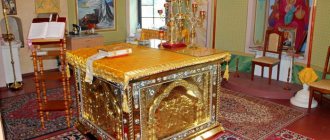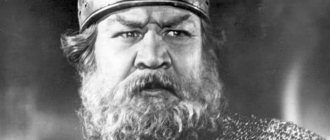Moore. Spaso-Preobrazhensky Monastery
Shrines of the city of Murom
Arriving in Murom
, this
ancient city of Orthodoxy, visit the Chapel of St. George the Victorious, which is located in the courtyard of the Transfiguration Monastery. Built in 2001 in memory of fallen soldiers. As a tourist, I can say that it is beautiful - snow-white in color and with an interesting dome. At the entrance there is an icon and a lamp. It is here that the holy relics of the martyr George are located. Every year on the sixth of May a solemn liturgy is held in his honor in the chapel.
Spaso-Preobrazhensky Monastery. Spaso-Preobrazhensky Cathedral and Church of the Intercession of the Virgin Mary with a hipped bell tower
Boris and Gleb Monastery
Shrines of the monastery
Since the founding of the monastery, the Vilna cross -reliquary - one of the first shrines of the monastery. On May 15, 1996, on the occasion of the fifth anniversary of the revival of the monastery, the ancient monastery shrine was returned to the monastery from the city history and art museum.
The main shrine of the monastery is the relics of the holy saints Prince Peter and Princess Fevronia , transported from the local museum on September 19, 1992. Until 1921, the relics rested in the city's Nativity Cathedral.
here rest the relics of the holy faithful Prince Peter and Princess Fevronia... The saints were canonized at a church council in 1547.
With their prayers they bring down heavenly blessings on those entering into marriage. The day of remembrance of the holy couple is set on July 8.
The Holy Trinity Convent was closed in 1933. On its territory there was one of the concentration camps of the Gulag system. Its revival of the monastery began only in 1991. Today it's hard to believe...
on the territory of the Holy Trinity Convent
Sights of Murom: Old Kozmodemyanskaya Church (XVI century), Spaso-Preobrazhensky Cathedral (XVI century),
Trinity, Annunciation and Spassky monasteries (XVII century), Vvedenskaya and Resurrection churches (XVII century); St. Nicholas Embankment Church, where the relics of Saint Righteous Juliana Lazarevskaya lie; Church of Kozma and Damian on the embankment on the road to the village. Karacharovo - the birthplace of the epic hero Ilya Muromets and other architectural monuments of Murom of the 17th-19th centuries, which made it one of the most beautiful cities of the “Golden Ring” of Russia.
Spaso-Preobrazhensky Monastery
Spaso-Preobrazhensky Monastery is one of the oldest in Russia. In terms of age, it is surpassed only by the Kiev Pechersk Lavra. The very nature surrounding the monastery puts you in an elevated mood - from the hill you can see the slowly flowing Oka River and the vast expanses of Murom and Nizhny Novgorod.
The founder of the monastery was the Holy Blessed Prince Gleb the Passion-Bearer. This is the first Russian saint - the son of the Kyiv prince Vladimir, who began the Baptism of Rus'. The first chronicle mentions of the monastery of the Savior on the Bor date back to 1096. And already in 1097, Prince Konstantin of Murom, thanks to a miracle, was able to baptize the pagan Murom tribe: he alone, without weapons, went out to the rebellious pagans and showed them the icon of the Mother of God, which shone like the sun. The pagans fell on their faces and were soon baptized in a nearby lake. The glory of the monastery was brought by many saints who honored the holy place with their presence, among them the holy noble princes Peter and Fevronia, St. Seraphim of Sarov and others.
The monastery owes the appearance of the majestic Spassky Cathedral to Ivan the Terrible. During the campaign against Kazan, the tsar's army passed through these places and the tsar made a vow - in case of victory, to erect a stone temple in Murom. As you know, Kazan was taken, and Ivan the Terrible kept his word, and in 1555 the city saw the beautiful Spassky Cathedral of the monastery. The sovereign donated church utensils, vestments, icons and books to the new temple.
At the end of the 19th century, the monastery acquired the icon of the Mother of God “Quick to Hear,” which was brought here from the distant Greek Holy Mount Athos in 1878. This icon not only shows many miracles - it streams myrrh, changes its face, but also provides assistance to those suffering who turn to it in prayer. It is especially famous for helping to get rid of demonic obsessions, improve households, and return missing people.
Next to the St. George Chapel there is a beautiful blooming pond, in the center of which a magical Lotus flower grows. Blooming pond in the Murom Spassky Monastery.
A little history: since January 1929, the Spassky Monastery was occupied by the military and partly by the NKVD department, at the same time the destruction of the monastery necropolis began, and access to its territory for civilians was stopped.
Boris and Gleb Monastery
This architectural miracle appeared on the banks of the Ushna by order of Prince Gleb. There is a legend that it was here that the daughter of the Murom prince Evdokia became a nun. But, unfortunately, back in 1719, due to a strong fire, the monastery was completely burned down. After this, they decided to unite the Boris and Gleb and Annunciation monasteries.
Annunciation Monastery
We can only see part of the monastery, but despite time and difficulties, there is still a functioning Church of the Nativity.
Annunciation Monastery. Monument to Peter and Fevronia
Annunciation Monastery. Church of the Nativity
Spassky Cathedral of the Transfiguration Monastery
Revival of the monastery
In the spring of 1995, military unit No. 22165 left the premises of the Spassky Monastery. Hieromonk Kirill (Epifanov) was appointed vicar of the reviving monastery, who was met with complete devastation in the ancient monastery. He later recalled: “A depressing picture appeared before my eyes. The domes collapsed, the roof was demolished, the barracks were piles of bricks. At first I couldn’t even imagine how to restore all this...” But a little later that same icon of the Mother of God “Quick to Hear” returned to the monastery, and the matter got off the ground. Little by little the brethren gathered, benefactors and knowledgeable helpers appeared, the monastery quickly rose from the ruins
In April 1990, the public of the city of Murom addressed an open letter to the Vladimir Diocesan Administration, as well as to the Chairman of the Murom City Executive Committee V.I. Zhukov with an open letter in support of the transfer of the Murom Spassky Monastery to the Russian Orthodox Church. The idea of reviving the monastery was advocated by Academician D.S. Likhachev, who addressed a letter to Patriarch Alexy of Moscow and All Rus' on October 8, 1990.
Stella to Peter and Fevronia near the wall of the monastery
Many saints stayed within the walls of the monastery: the holy noble princes Peter and Fevronia (1205 - 1228), the Murom miracle workers and family benefactors (Prince Peter took monastic vows here and died).
Resurrection Convent
- an Orthodox convent located in the north-eastern part of Murom (in July Lane) on Fruit Mountain. According to legend, it arose on the site of the country palace of princes Peter and Fevronya of Murom. The first mention of the monastery dates back to the 16th century. The architectural complex of the monastery has survived to this day. It is represented by buildings of the 17th century - the five-domed Church of the Resurrection with a refectory and bypass gallery with hipped porches and the single-domed gateway Church of the Vvedenskaya with a hipped bell tower.
Annunciation Monastery.
The Murom Annunciation Monastery arose from the modest wooden Church of the Annunciation of the Blessed Virgin Mary. Church tradition attributes its construction to St. bl. Prince Konstantin (Yaroslav) Svyatoslavich - the son of the Chernigov prince Svyatoslav, the grandson of the great Kyiv prince Yaroslav the Wise. According to church legend, the inhabitants of Murom for a long time professed a pagan religion that deified the forces of nature. Having heard about this, Prince Konstantin begged Murom from his father as his inheritance in order to convert the inhabitants of the city to the Christian faith. His sons Mikhail and Fedor helped him in this godly work. The Murom pagans, not wanting to accept the prince, killed his youngest son Mikhail. Struck by a miraculous sign from the icon of the Mother of God, later called Murom, they repented of their crime and were baptized in the waters of Lake Kstovo, located not far from the city.
Soon, on the “Old High Fortified Settlement”, fortified with a tine and earthen ramparts, the first Murom church was erected in the name of the Annunciation of the Blessed Virgin Mary. A princely palace was erected nearby. The body of the murdered Prince Mikhail was laid at the temple. Gradually, the entire princely family found peace near the walls of the Annunciation Church. In 1547, on the basis of local veneration, the church-wide canonization of the blessed Prince Constantine and his children Mikhail and Fedor was carried out.
The monastery was founded on the site of the Annunciation Church according to the vow of Tsar Ivan the Terrible.
He visited Murom in 1552 during a campaign against Kazan, fervently prayed to the new miracle workers for victory, and promised, if successful, to establish a monastic monastery. After the capture of Kazan, a team of architects arrived in Murom. During the construction of the stone temple, tombs with the relics of the princes were found, which were solemnly placed in the new Annunciation Cathedral with prayer singing.
The Annunciation Monastery enjoyed the highest favors. The tsar sent all the necessary utensils for church needs, gave the brethren “inexhaustible alms” and land holdings, which expanded in the 17th century.
In 1616, the monastery was ravaged by the Poles, plundering many relics granted by Ivan the Terrible. New “sovereign alms” helped restore the monastery. The cathedral was rebuilt again. In 1652, the chapel of St. John the Evangelist was added to it. At the end of the 17th century, a high tented bell tower was erected next to the Annunciation Church. Currently, the Annunciation Monastery is a unique treasury of ancient Russian Orthodox culture. Today, daily monastic services are held there and spiritual and educational activities are conducted.
Spassky Cathedral of the Transfiguration Monastery
This is incredible beauty and energy. It is simply impossible to confuse him with others. This is a temple with five beautiful domes - a well-deserved architectural monument of the 16th century. It is also part of a monastery located near Oka. The cathedral was created by decision of Ivan the Terrible in order to perpetuate the capture of Kazan. Although the cathedral is large, its design is quite strict.
Here you will not see any special luxury of painting - everything is modest. The temple went through reconstruction many times, and in the 90s, restorers returned the temple to its original appearance as much as possible.
Nikolo-Embankment Church
Nikolo-Embankment Church
Thanks to its beautiful domes, the Nikolo Embankment Church is visible from afar. It has a second name - “Nikola Wet”, which it received due to the fact that during the flood of the river the water reaches the very walls! The church is dedicated to Nicholas the Wonderworker, who is the patron saint of travelers. So be sure to check it out.
A church was created in the “Moscow Baroque” style. The main relic is the relics of Juliania Lazarevskaya. Nearby there is a healing spring, near which many visitors to holy places have seen the holy spirit. Pilgrimage
here is considered almost obligatory for every Orthodox Christian.
Temple of the Smolensk Icon of the Mother of God
Address and schedule of services
Many believers are certainly drawn to visit these holy places, and the question immediately arises in their minds: “How does the Peter and Fevronia of Murom Monastery work?”
Every day, divine services are held on the territory of the monastery. The morning liturgy begins early in the morning, at 6.30, the evening liturgy at 16.00. At the end of the liturgy, prayers and memorial services are read for the departed
On Sundays, the liturgy begins at 7.00 am; after this liturgy, a water blessing prayer service with an akathist is held in front of the relics of Saints Peter and Fevronya and a procession of the cross is held.
Temple of the Smolensk Icon of the Mother of God
Many people come to the Church of the Smolensk Icon of the Mother of God. This is an Orthodox church, which was created in 1804. It was recreated on the site of a church that burned down in a fire. The church was completely looted and given over to pop performances, but in 1995 the temple was returned to the Orthodox Church. It is also worth visiting another architectural monument of the city - the water tower. It was erected in 1863 by the decision of A.V. Ermakov, who at that time was the head of the city. Thanks to her, eight fountains worked in the city. There would have been ten of them if not for the First World War...
Holy Trinity Convent
History of the monastery
Getting to the topic: “Murom: the monastery of Peter and Fevronia,” let’s plunge a little into the ancient history of Rus'. This monastery was founded by the Murom merchant Tsvetnov Tarasy Borisovich in 1643. Previously, during the period of the 11th-13th centuries, an old settlement with a wooden cathedral of the holy princes Boris and Gleb was located on this site; a little later, the Holy Trinity Church was built here from wood.
Thanks to the efforts and hard work of the merchant Tsvetnov, who received the blessing of the Bishop of Ryazan and Murom, in 1643, instead of a wooden church, the White Stone Holy Trinity Cathedral was erected on this site, which has survived to this day.
Holy Trinity Convent
trip here , visit the monument to Ilya Muromets - this is a real mystery in the Russian epic. This is a real hero, warrior and defender of Russian lands. In this city, local residents are sure that this character really existed and, quite possibly, that is exactly what happened.
Monument to Ilya Muromets
Also look at the beautiful fountain that is located in the Holy Trinity Convent. In Murom, everyone will find their own corner of peace and faith.
Fountain in the Holy Trinity Convent
Opening of the monastery
On May 15, 1991, a long-awaited event happened: on the day of remembrance of Saints Boris and Gleb, the opening of the Holy Trinity Convent for women took place. And a few days later, on May 22, 1991, nun Tabitha (Golanova), who later became his abbess, arrived here. The Murom Monastery has several farmsteads: Holy Cross (Murom), Bogoroditskoye (village Mishino, Murom district), Bogoroditskoye (Vladimir region, Kameshkovsky district).
In 2001, a boarding house for elderly people and minor children called “Nadezhda” was created in the monastery. Under the patronage of this holy monastery there are also several prisons, a juvenile colony, a military unit and the Phoenix Society for wheelchair users.
How to get to Murom
You can get to the city by train, bus or car. Buses leave from the central station. You can also get there by train, reaching the Vladimir station, and then a little further by bus.
Holy Resurrection Cathedral
In the previous article the author wrote about: Sacsayhuaman
The next article by the author will be about: Kurumnik on the Korbu ridge, Altai
